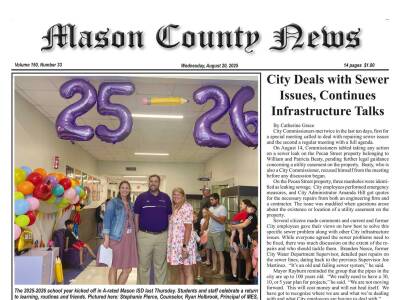Most of this column was written nine years ago to describe the changes that had occurred in the vegetation inside our high fence the previous 11 years. Obviously, we made numerous changes by planting things and cutting back other things, but the discussion below pertains only to the natural changes as some things grow, some things die and some things propagate new plants with no involvement by us. It is these natural changes that I want to concentrate on here.
We put up a high fence around the house even before we had moved in, because experience here and elsewhere told us Mother Nature has her own ideas about growing things.
The one acre inside the fence is part of a larger property of an overgrazed, overbrowsed working ranch that is a rocky savanna with most trees showing a distinct browseline and less grass and forbs than ideal conditions.
The acre around the house, inside the fence, had 40 mature hardwood trees (mostly live oaks, blackjack oak and post oaks) and 10 cedar trees when we fenced it. Since that time, we have lost one blackjack oak to hypoxylon and the top of another.
I walked around the yard (nine years ago) counting the small shoots and saplings of hardwood trees and vines that had come up on their own in the past 11 years. It was not an exhaustive search and I undoubtedly missed some, and there have been others that we have either removed, dug up to grow in pots or died, so the numbers are certainly low. I found 108 hardwood tree and shrub sprouts and saplings that we had nothing to do with their being there. In other words, these were all “volunteers” and represent what Mother Nature put there by herself.
Many of these sprouts (37) were live oaks, post oaks and blackjack oaks that may well have been root sprouts of mature trees inside the fence. But the rest were of species that were growing no closer than a few hundred yards away and some we have no idea where the closest source of seeds was, such as hackberries, gum bumelia, mesquite, and rusty blackhaw viburnum. Now, in 2021, there are blackjacks, escarpment black cherries, hackberries and prairie flameleaf sumacs that are mature, some over 18 feet tall!
We also have over 50 native vine plants which have established themselves around the yard, including greenbrier, grape, and Virginia creeper.
We have planted a number of native shrubs which have grown to produce berries which have been the source of new plants scattered around the acre, presumably by birds and small animals, such as possumhaw, and golden ball lead tree, and some of which also produce root sprouts, including roughleaf dogwood, Blanco crabapple, and trumpet creeper.
In addition, numerous native grasses and wildflowers planted in specific places over the years have produced seeds that obviously traveled to other places in the yard and reseeded themselves.
It is important to note that none of these new plants can be seen outside the high fence. Some may have sprouted there, but didn’t survive the herbivoires.
The point of all of this is just to illustrate how Mother Nature propagates her plants and establishes replacement plants for her trees, shrubs, vines, forbs and grasses, and to note that it means that this process is still operating even in areas that have been seriously overgrazed and overbrowsed for some time. All that is required is to protect the young plants from the overabundant herbivores, native and non-native, that are out there.
Of course, not all of the woody sprouts will make it to maturity, and in areas not fenced, but having lower (more “normal”) animal numbers, some would certainly have been eaten, but some would escape and that is how the diversity of Hill Country vegetation is perpetuated. But that is also why we need to manage the total herbivore populations in order to have a variety of native vegetation.
Probably not all of the 108 woody sprouts will be allowed to become mature trees or vines, because the place would become an over-shaded jungle. But to the extent possible, many of these new plants will survive and we have halped to maintain the seed bank for native species and to maintain a healthy habitat for native birds and animals.
Plus, it is just fun to watch Mother Nature do her thing.
Come by Riverside on Fridays from 10 to 12 and let’s talk.
Until next time…
Jim Stanley is a Texas Master Naturalist and the author of the books “Hill Country Ecology,” “Hill Country Landowner’s Guide” and “A Beginner’s Handbook for Rural Texas Landowners.” He can be reached at [email protected]. Previous columns can be seen at www.hillcountrynaturalist.org.


